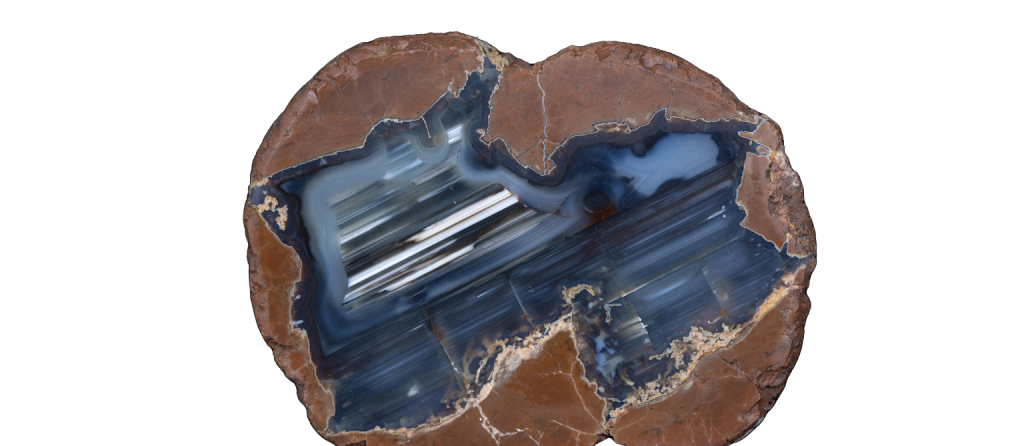Thunder Eggs
Thunder Eggs
Thunder Eggs
Thunder Eggs
Thunder Eggs
Thunder Eggs

About Thunder Eggs
Thunder eggs are unique geological formations that captivate both scientists and collectors alike. Also known as geodes, thunder eggs are spherical or oval-shaped rocks that contain stunning crystal-filled cavities within their hardened outer shells. These extraordinary formations are created through a combination of volcanic activity and the slow deposition of minerals over time.
The outer shell of a thunder egg is usually composed of solid or layered rock, such as rhyolite or basalt, and displays a rough and often weathered texture. However, it is the hidden interior that truly steals the show. When a thunder egg is cracked open, it reveals a mesmerizing world of vibrant colors, intricate patterns, and shimmering crystals.
The inner cavity of a thunder egg can vary in size, ranging from a few centimeters to several meters in diameter. Within this cavity, a variety of minerals can be found, including quartz, agate, amethyst, jasper, and calcite. These minerals create breathtaking displays of color, with hues ranging from translucent whites and vibrant reds to deep blues, greens, and purples. The patterns formed by the crystals can be intricate and delicate, resembling flowers, waves, or intricate geometric shapes.
Each thunder egg is a unique work of natural art, with no two being exactly alike. Their beauty and rarity have made them highly sought after by collectors and enthusiasts around the world. Thunder eggs are often polished and shaped into decorative pieces such as bookends, paperweights, or jewelry, allowing their captivating interior to be admired and cherished.
Where are Thunder Eggs found?
Thundereggs are found globally where conditions are optimal. In the US, Oregon is one of the most famous thunderegg locations. Germany is also an important center for thunderegg agates (especially sites like St Egidien and Gehlberg).
History
The history of thunder eggs is intertwined with the geological processes that shape our planet. Thunder eggs have their origins in volcanic activity that occurred millions of years ago. The formation process begins when molten lava is expelled during volcanic eruptions and spreads across the surface. As the lava cools and solidifies, it forms rocks such as rhyolite or basalt, which serve as the outer shell of thunder eggs.
Inside these volcanic rocks, gas bubbles and cavities can form. Over time, mineral-rich fluids, often derived from groundwater, seep into these cavities. These fluids carry dissolved minerals such as silica, iron oxides, and other compounds. As the fluid slowly evaporates, it leaves behind deposits of these minerals within the cavities.
The process of mineral deposition can take thousands or even millions of years, as layers upon layers of minerals accumulate. The specific composition of the minerals and the conditions under which they form determine the colors, patterns, and types of crystals found within thunder eggs.
Thunder eggs are found in various regions across the globe. In the United States, the state of Oregon is particularly renowned for its thunder eggs, with locations such as Richardson’s Rock Ranch and Graveyard Point being famous collecting sites. Other countries like Australia, Brazil, Mexico, and Morocco also have notable thunder egg deposits.
The recognition and appreciation of thunder eggs as fascinating geological specimens grew over time. They became sought-after by collectors and enthusiasts who marveled at their unique beauty. In the mid-20th century, thunder eggs gained popularity as lapidary materials, with artisans and craftsmen cutting and polishing them to reveal their stunning inner landscapes. Thunder eggs have since become treasured pieces in jewelry, decorative items, and geological collections worldwide.
While thunder eggs have a rich geological history, they also hold cultural significance. Native American tribes, as mentioned earlier, associated the formation of thunder eggs with thunder gods. In their folklore, these rocks were believed to hold mystical powers and were sometimes used in spiritual rituals.
In summary, the history of thunder eggs spans millions of years, beginning with volcanic activity and continuing through slow mineral deposition. Their allure has grown over time, captivating both scientists and enthusiasts alike. Today, they are cherished for their natural beauty, scientific value, and the captivating glimpse they provide into our planet’s geological past.
Lore
The origin of the name “thunder egg” is rooted in folklore. Native American tribes believed that these peculiar rocks were formed by thunder gods during thunderstorms. The cracking sound of thunder was thought to be the gods’ work in shaping these extraordinary creations. Hence, the name “thunder egg” has persisted and become synonymous with these remarkable geological wonders.
Metaphysical
Metaphysical properties attributed to thunder eggs are based on various belief systems and spiritual traditions. It’s important to note that these properties are not scientifically proven, and individual experiences and interpretations may vary. Here are some metaphysical properties commonly associated with thunder eggs:
- Grounding and Stability: Thunder eggs are believed to possess grounding properties, helping individuals connect with the Earth’s energy. They are thought to promote stability, balance, and a sense of security.
- Protection: Thunder eggs are associated with protective energies. It is believed that they can create a shield of energy, guarding against negative influences, psychic attacks, and electromagnetic radiation.
- Healing and Transformation: Thunder eggs are often considered to have healing properties, both physically and emotionally. They are believed to promote inner strength, emotional resilience, and support during times of change or transition.
- Amplifying Energy: Thunder eggs are thought to enhance and amplify energy, making them useful for meditation, manifestation, and spiritual practices. They may assist in focusing intentions and increasing the effectiveness of affirmations or intentions.
- Spiritual Connection: Thunder eggs are associated with expanding consciousness and facilitating spiritual growth. They are believed to assist in connecting with higher realms, spirit guides, and one’s own intuition.
- Emotional Balance: Thunder eggs are thought to aid in emotional healing and balance. They may promote inner peace, calmness, and the release of negative emotions.
- Creativity and Inspiration: Thunder eggs are often regarded as stones that enhance creativity and inspiration. They are believed to stimulate the imagination, encourage creative thinking, and support artistic pursuits.
- Harmony and Unity: Thunder eggs are associated with the concept of unity and harmonious relationships. They are believed to promote cooperation, understanding, and the resolution of conflicts.
It’s important to remember that these metaphysical properties are based on belief systems, spiritual practices, and personal experiences. If you’re interested in working with thunder eggs or any other crystals or stones, it’s recommended to explore and experiment with them yourself to determine how they resonate with you personally.
